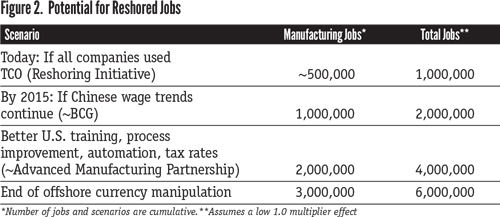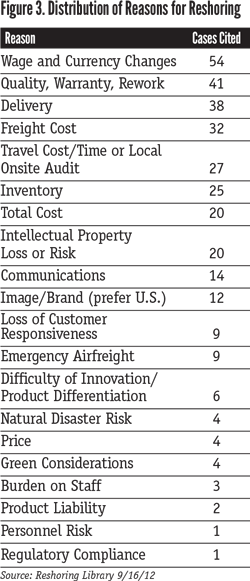This article is a follow-up to the VMA & VRC 2012 Annual Meeting presentation by Harry Moser, founder and president of the Reshoring Initiative. The non-profit Reshoring Initiative is dedicated to helping companies understand the true cost of offshoring by using Total Cost of Ownership (TCO) analysis. The initiative provides free TCO estimator software, as well as a database of more than 300 reshoring articles and case studies where companies can share their experiences with reshoring.
As companies adopt more comprehensive total cost analyses, they are finding that offshore labor rates have risen enough that the “hidden costs” of offshoring often counterbalance savings from lower pricing. China is a good example since labor rates have been rising there at about 18% per year. Because of those rates, as well as other reasons, a new trend in sourcing decisions for U.S. manufacturers is emerging: reshoring or returning to local sourcing.
This shift in understanding and approach has major positive implications both for individual companies and the national economy. Reshoring can improve the bottom line for many companies while it also brings jobs back to the nation and makes the U.S. more self-sufficient.
Some analysts also say Americans increasingly prefer American-made products. If this is true and the resurgence of American sourcing continues, this nation may well see a large reduction in imports, which could be the most efficient way to lower the trade deficit, and thus the budget deficit and unemployment.
Analysis of user data shows that using TCO instead of price in sourcing decisions makes a difference in 41% of cases, and that about 25% of what has been offshored would come back if all companies used TCO instead of price for decision making. Figure 1 shows how the initiative came to that conclusion. It is based on the most recent 27 cases of China vs. U.S.
From this data, we concluded that the use of TCO instead of price could change the sourcing decision on 41% of the cases. The initiative uses a more conservative figure to say we believe it would change the decision in about 25% of cases.
For this potential to be realized, however, more companies must adopt TCO analysis.
In its March 12, 2012 “Made in America” report, the Boston Consulting Group (BCG) identifies seven industry sectors as being at or near the tipping point, where it will make economic sense for sector production to return to the U.S. if companies look at TCO. Several of those sectors are relevant to valve manufacturing and use. Those industries are:
- Transportation goods
- Computers and electronics
- Fabricated metals
- Machinery
- Plastics and rubber
- Appliances and electrical equipment
- Furniture
TCO analysis helps to objectively identify, forecast and minimize total cost, including rising costs of wages and currencies in countries with low labor costs and low energy and transportation prices. However, other factors, such as risks of supply chain shocks and disruptions caused by natural disasters and political instability, also play a role in the current shift back to this shore. Figure 3 shows the frequency of reasons cited for reshoring.
How to Calculate TCO
To determine the TCO with the initiative’s TCO Estimator, users assign a value to each factor that is relevant to that specific case. The tool then accumulates a single cost value for a product sourced from a particular supplier. Users repeat the process for each of their vendors, and can then objectively compare the TCO for the same type of product from multiple vendors, whether that vendor is local or offshore. The costs addressed in the TCO Estimator, beginning with “hard cash” costs and progressing to more subjective measures, are:
1. Cost of goods sold or landed cost includes price, packaging, duty and planned freight such as surface shipment, fees and insurance.
2. Other “hard” costs are those that can be calculated and are highly likely to occur, including:
- Carrying cost for in-transit product. Payment for foreign products often occurs prior to shipment whereas domestic shippers are paid after shipment. In-transit times are longer.
- Carrying cost of inventory on site. On-site inventory will be dramatically higher for products shipped by ocean freight than for shipments from a local, just-in-time supplier. Large inventories associated with offshoring also are a risk in the next business downturn.
- Prototype cost. Sourcing prototypes locally allows engineers and marketing organizations to work more effectively with suppliers during product development. Local suppliers typically charge less for the prototype if they also receive the production orders.
- End-of-life or obsolete inventory.
- Travel costs. Ongoing auditing and problem solving can have a notable impact on a product’s total cost.
3. Potential risk-related costs. High-frequency risks, such as emergency airfreight, scrap and rework, to name a few, can be calculated based on past experience with an existing supplier. New products or new suppliers will require estimates. Such risks include:
- Rework
- Quality
- Product liability
- Intellectual property risk. Approximately 5% to 7% of world trade consists of counterfeit or pirated goods.
- Opportunity cost
- Brand image. Consumers increasingly are buying locally made goods as a way to help the economy and their neighbors.
- Economic stability of the supplier
- Political stability of the source country
4. Strategic costs that may have an impact on strategy are considered as well. Such “costs” include:
- Impact on innovation. Separating manufacturing from engineering degrades the innovative effectiveness of a company and its home country. Conversely, there is a large advantage for innovation that can be done within “clustering”—having suppliers, research universities, manufacturing, development and production located near each other.
- Product differentiation and mass customization. It is easier and less costly to make the move to mass customization with short, tightly clustered supply chains.
5. Environment. Finally, for each product source, some companies measure the cleanliness of production. “Green” quantification will be added to a future version of the TCO Estimator.
Maximized Strategy
When it becomes clear that considering TCO carries little or no penalty for domestic sourcing, it is easier for a company to justify the reality that more emphasis and resources can be placed on strategies for product differentiation or product innovation because they can be maximized via local sourcing. A company might pursue local cost-reduction programs, for example, such as lean, theory of constraints, design for manufacture and assembly, quick response manufacturing, automation or training—programs that might seem insufficient with a 40% price gap but easier to justify at a 10% TCO gap.
TCO use and industry awareness of the potential benefits of reshoring are essential components of rebuilding the U.S. industrial base. When companies understand the total cost of ownership, they offshore less and reshore more. This is one reason why individual companies, educational institutions, Wall Street and consumers are starting to embrace reshoring. The White House is also taking note: In January 2012, the Administration hosted an “Insourcing Forum” (the initiative was on the agenda) and President Obama summarized in his 2012 State of the Union that, “…We have a huge opportunity, at this moment, to bring manufacturing back. But we have to seize it.”1
TCO is showing more companies they can help both themselves and America by bringing back production.
Harry Moser is founder and president of the Reshoring Initiative. Millar Kelley is research analyst at the Reshoring Initiative. Both can be reached through www.reshorenow.org.
1 “Management: How to Make It in America,” Quality Magazine, April 6, 2012
HOW YOUR COMPANY CAN HELPDuring the Sept. 22, 2012 presentation at the VMA & VRC Annual Meeting, the Reshoring Initiative learned that VMA members would buy more valve castings in the U.S. if the domestic castings industry could meet demand for size and delivery. The initiative has connected the American Foundry Society (AFS) with VMA to initiate discussions of how to bring back the casting sourcing, benefiting valve makers, foundries and the country. VMA will be communicating with members on how to participate in this effort. In the meantime, here are some ideas for helping in the reshoring effort:
|
RELATED CONTENT
-
An Introduction to Axial Flow Check Valves
Check valves are self-actualizing devices that respond to both pressure and flow changes in a piping system.
-
Selecting Non-metal Materials for Valve Components and Coatings
Non-metallic materials are commonly used for valve components, and the selection of non-metallic materials for valve design and for application-specific conditions is critical to ensuring product reliability.
-
Stop Check Valves
Stop check valves are vital to several industries to protect boilers and other equipment.











 Unloading large gate valve.jpg;maxWidth=214)


